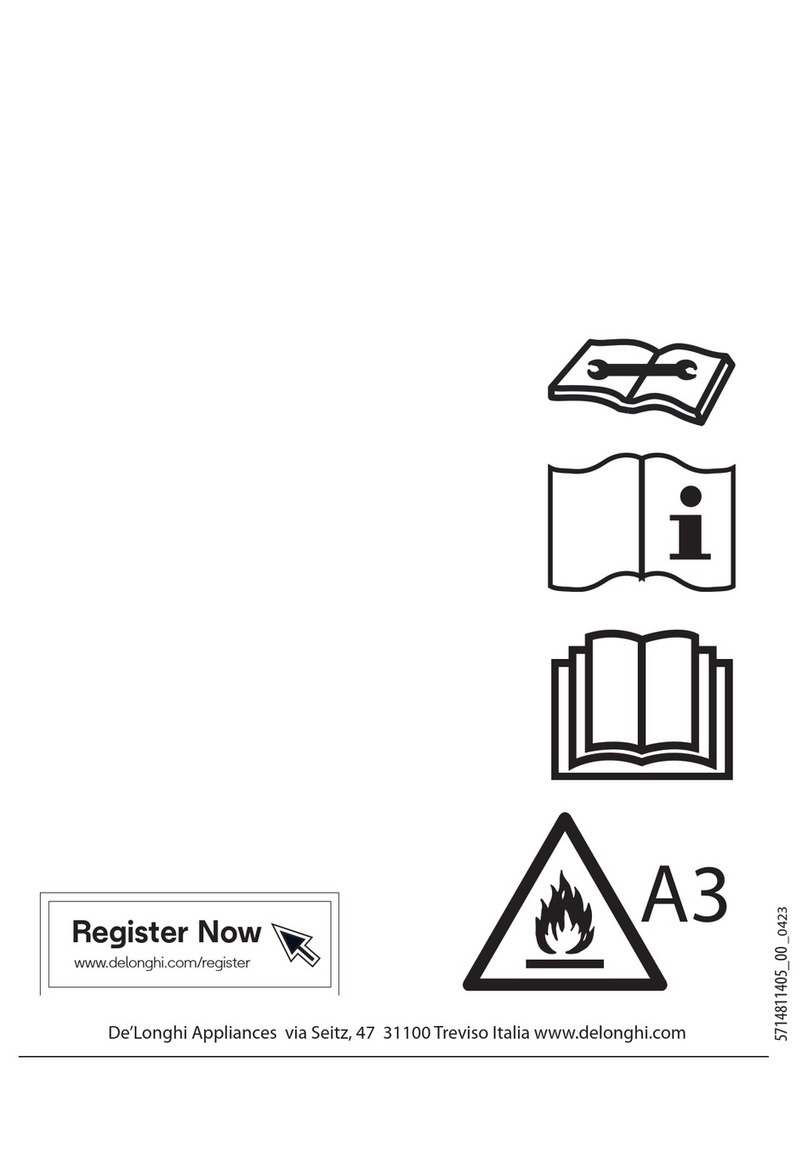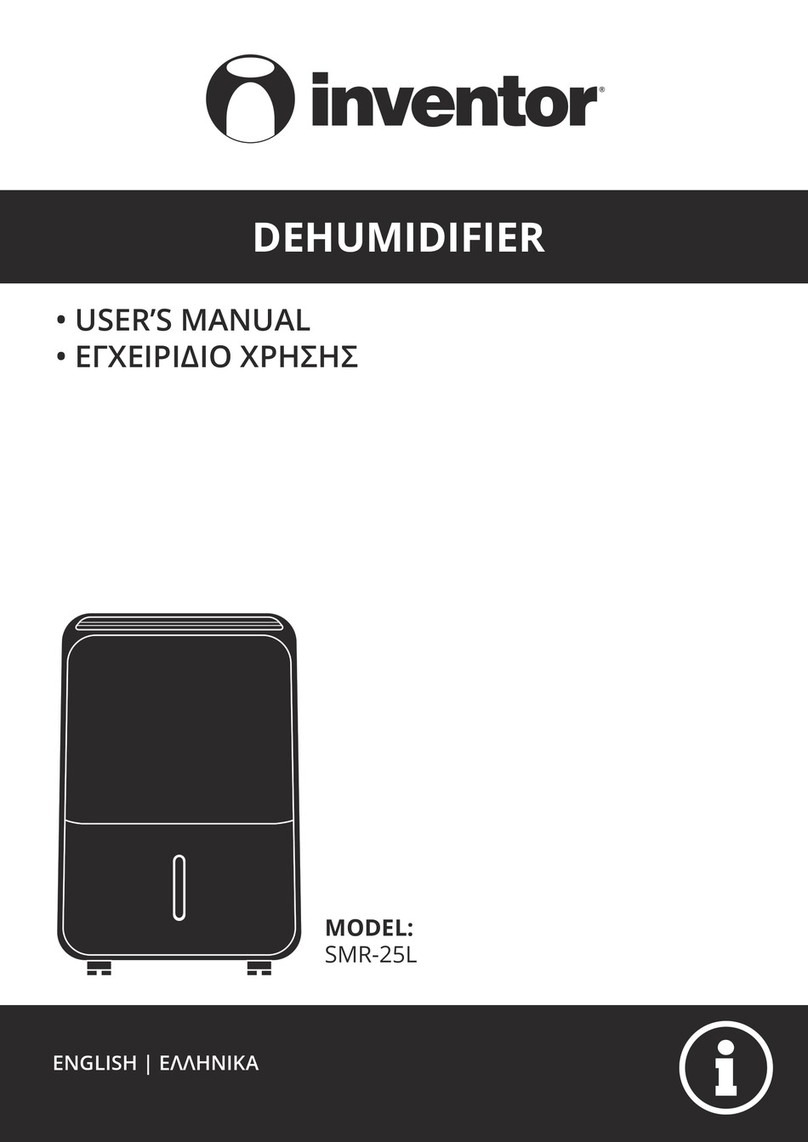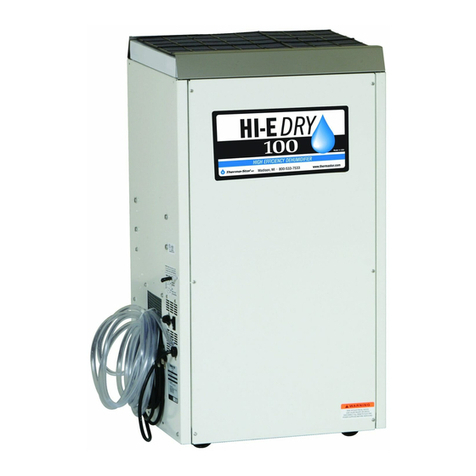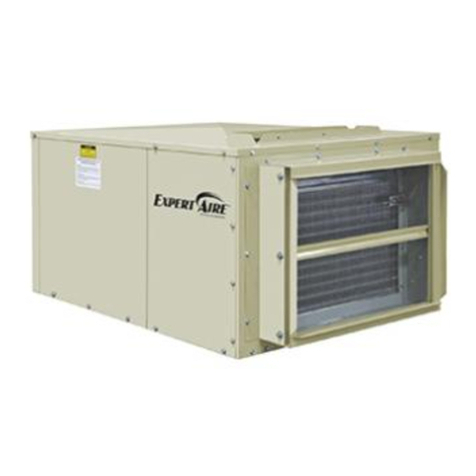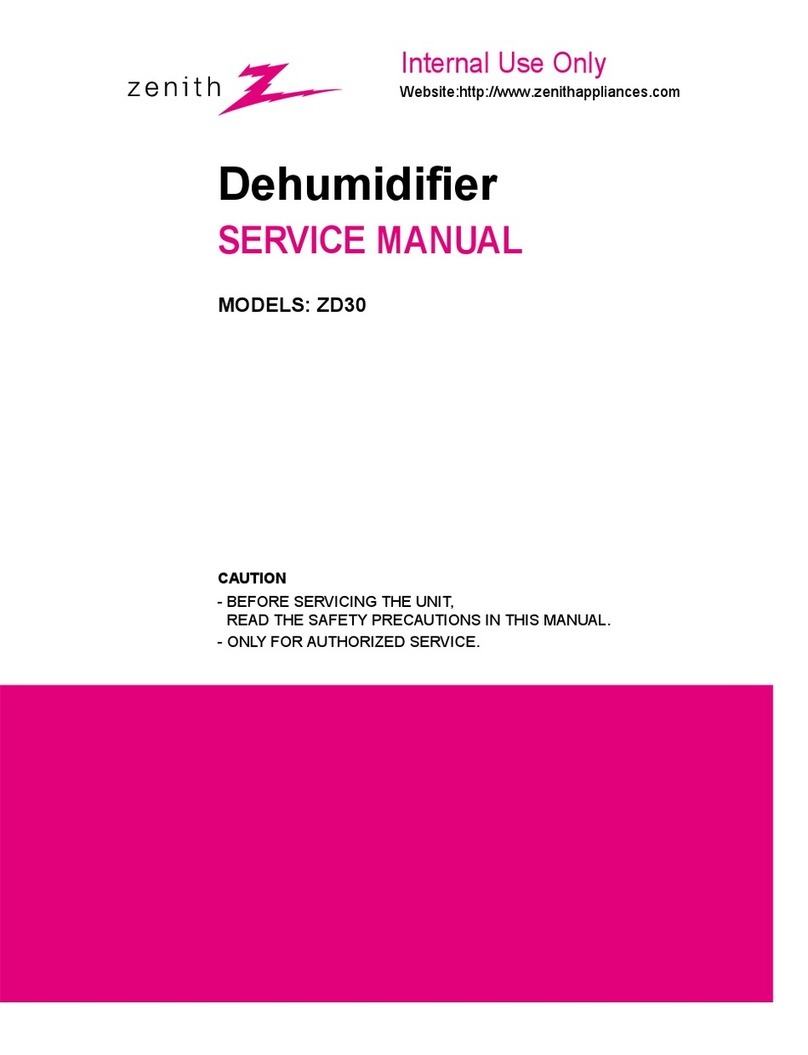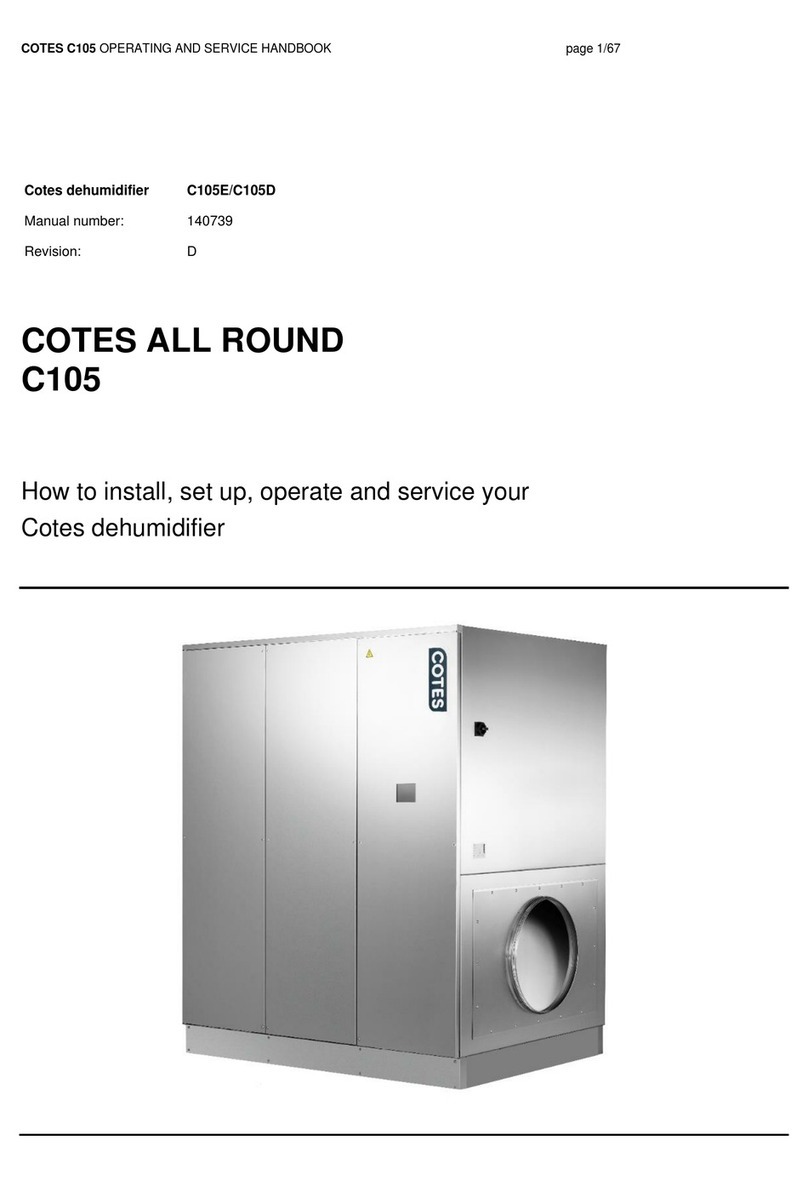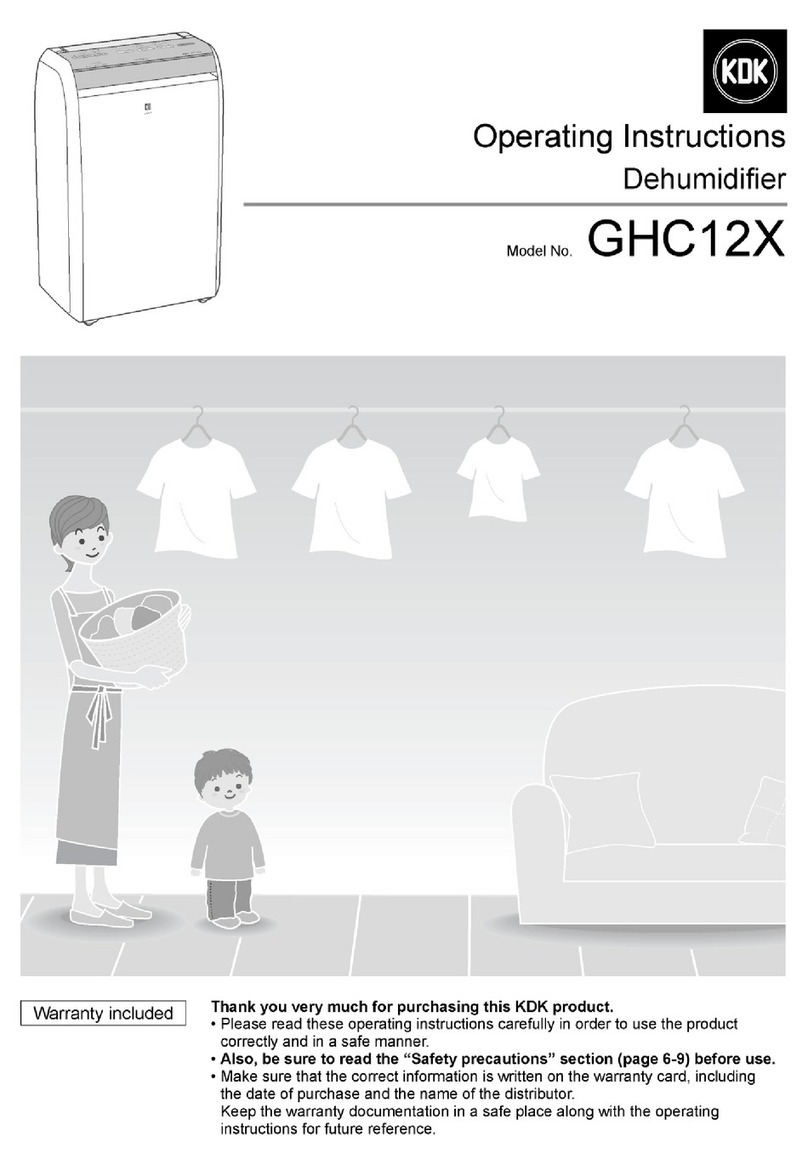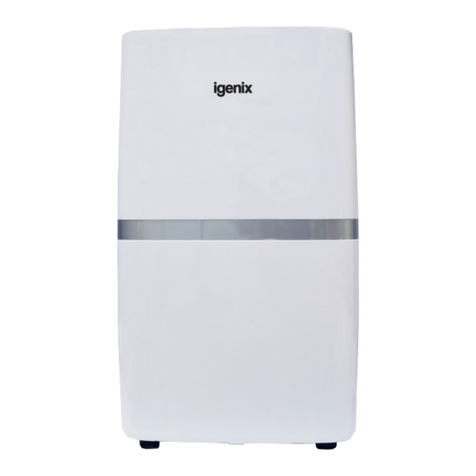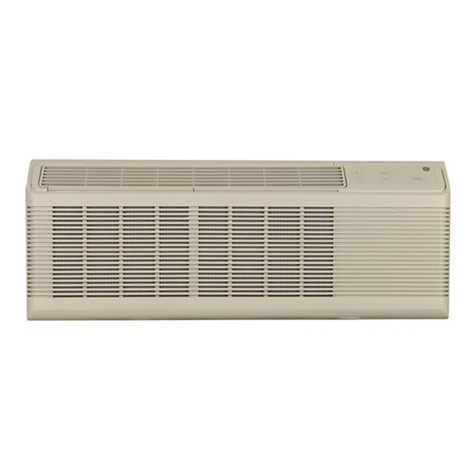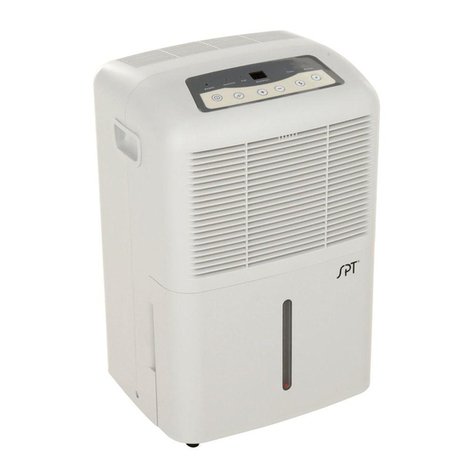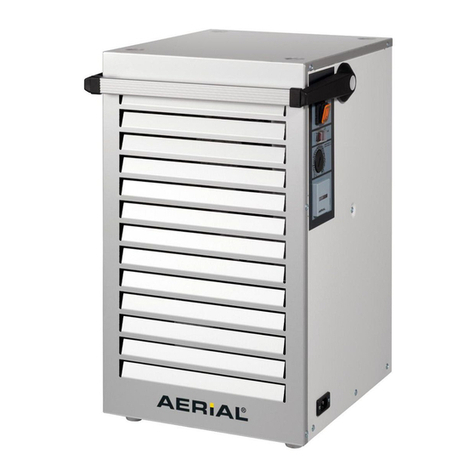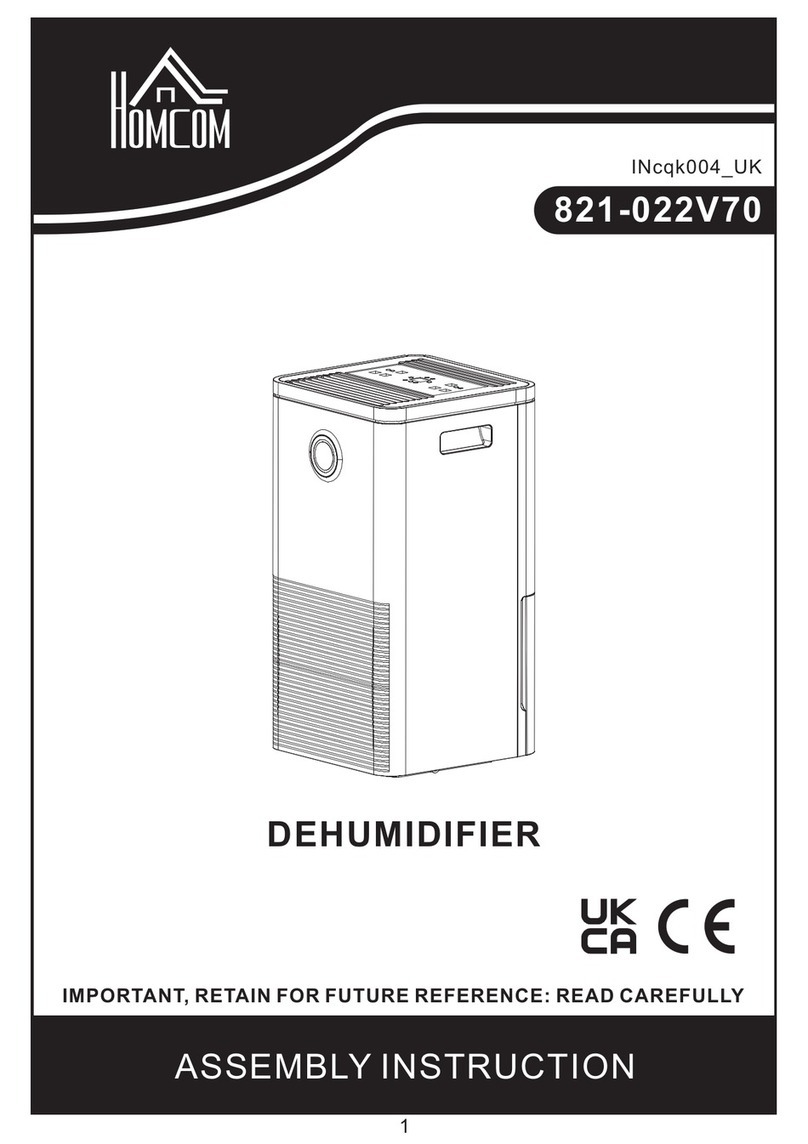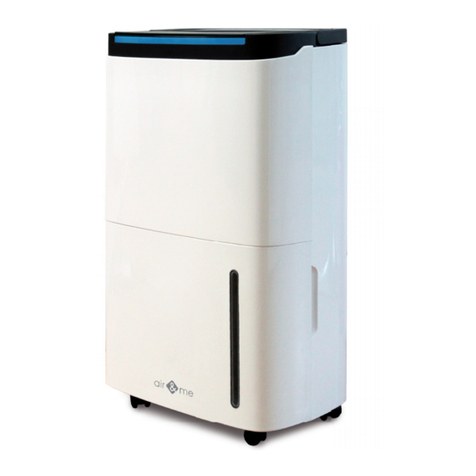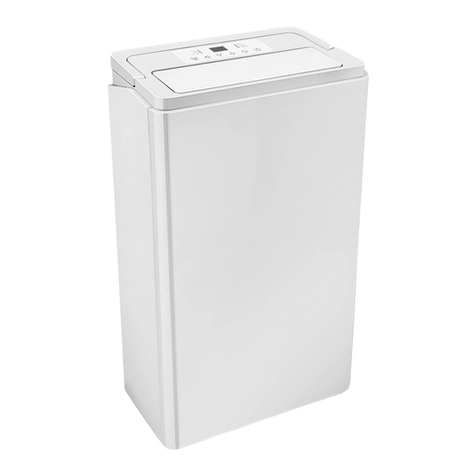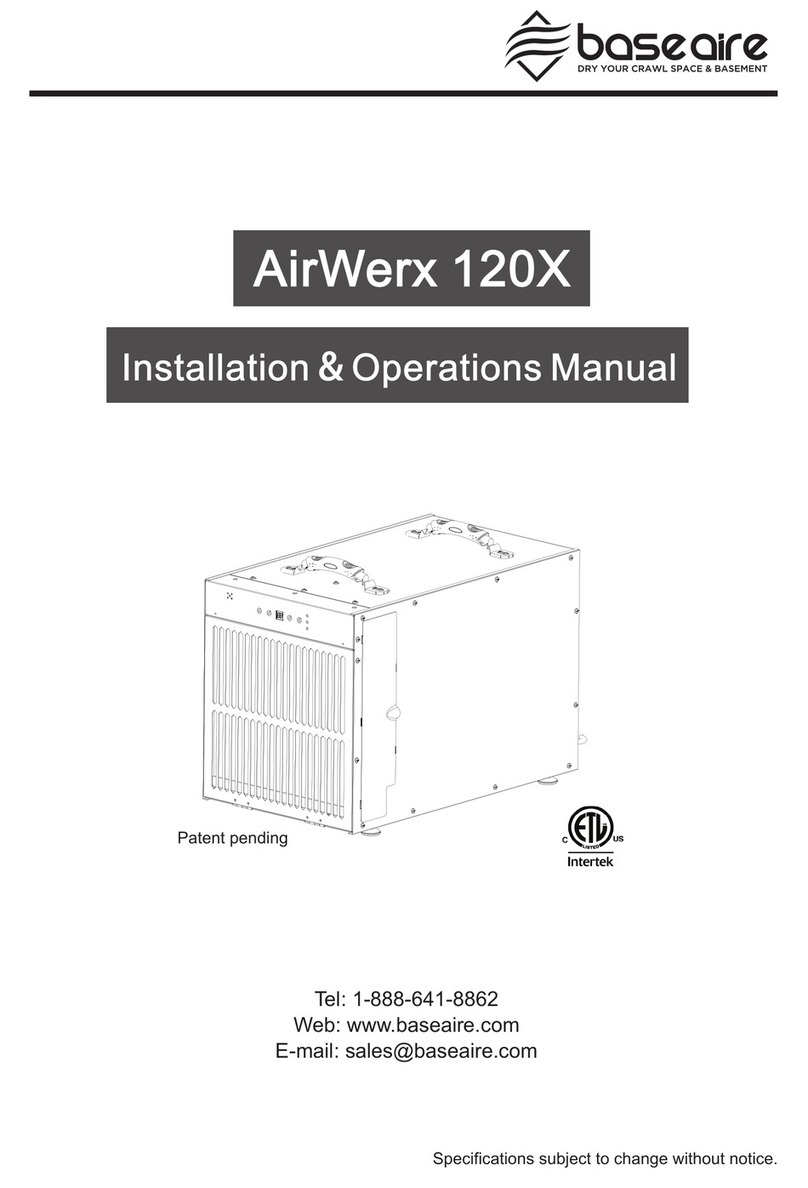CREST ULTRASONICS OPTIMUM CONSOLE OCJ-1014 User manual

Instruction
Manual
OPTIMUM CONSOLE
TM
JUNIOR AND
OCJ RECIRCULATING HOT AIR DRYER
Models: __ OCJ-1014, __ OCJ-1218, __ OCJ-1826, and __ OCJ-2424
(schematics provided herein for model checked above)
MANUAL 9907-103-OJSTD
CREST ULTRASONICS CORP.
Scotch Road at Mercer County Airport
P.O. Box 7266, Trenton, New Jersey, U.S.A. 08628
Phone 609 883-4000
•
Fax 609 406-7046
•

Crest Ultrasonics Corp.
Manual #9907-103-OJSTD •Page 2
TABLE OF CONTENTS
Section 1 General Information
1.1 Introduction: How to Use This Manual 3
1.2 Fundamentals of Ultrasonic Cleaning 4
1.3 General Safety Procedures 7
1.4 QUESTIONS? 10
Section 2 Installation and Start-up
2.1 Inspection, Placement and Leveling 12
2.2 Installation 13
2.3 Start-up and Processing 19
2.4 “Process Supervisor” Designation 24
2.5 Principles of Routine Operation 25
2.6 Daily Start-up 27
2.7 Daily Shut-down 30
Section 3 Maintenance and Options
3.1 General Maintenance 31
3.2 Special System Options (not included
on all machines):
A. Decanter/Coalescer Units 32
B. Rotation 36
C. Reservoir Pumpout System 38
D. Automatic Metering (for detergent,
rust inhibitor, or other additive) 41
E. Auto Rinse Water Flow Control
(“Timed Cascade”) 42
F. Auto Rinse Water Flow Control via
Resistivity Probe and Monitor 43
G. Auto-lid 45
H. Lip Vent Exhaust 46
Section 4 Reference
Hot Air Dryer
Specification and Engineering Drawings
“Maintenance and Troubleshooting”
Publ. IM-5310 (Generators and Tanks)
Timer and Temperature Controller

Crest Ultrasonics Corp.
Manual #9907-103-OJSTD •Page 3
1.1 INTRODUCTION:
How to Use This Manual
THANK YOU for selecting Crest Ultrasonics Corp. to
meet your precision cleaning needs. As the world’s leading
manufacturer of ultrasonic cleaning systems, we pledge to
keep earning your valued confidence with dedicated
customer service and support. For a list of support
services at Crest, please see Section 1.4 of this manual.
This manual describes the concept, design, and operating
principles of Crest Ultrasonics cleaning, rinsing, and drying
machines. For the installation, operation, and
maintenance of this machinery you should combine a
study of this manual with careful reference to the
schematics and assembly drawings provided.
We also urge you to familiarize yourself with Publication
IM-5310, which describes in detail the unique and superior
design of Crest generators, transducers, and ultrasonic
tanks. This booklet is in “Reference.”
In some cases, the sequences of operation discussed in
this manual may need to be modified by you slightly when
the machine is interfaced with special facility-supplied
plumbing, electronics, or equipment, and/or when special-
order components are installed on the machine. In these
instances, you should carefully consult the supplied
schematics and assembly drawings.
Engineering drawings for the system are supplied with this
manual to assist you with installation and start-up. Your
installation and operating personnel should consider these
final as-built drawings the most up-to-date and
authoritative reference documentation on the machine.
If you need documentation beyond what is provided in this
manual, please contact:
Engineering Department
Crest Ultrasonics Corp., P.O. Box 7266
Scotch Road at Mercer County Airport
Trenton, New Jersey 08628 U.S.A.
Tel. (609) 883-4000
Fax (609) 406-7046

Crest Ultrasonics Corp.
Manual #9907-103-OJSTD •Page 4
1.2 FUNDAMENTALS OF ULTRASONIC
CLEANING
Ultrasonic energy is activated in a liquid by means of
transducers that convert electrical energy to acoustic
(sound) energy. Transducers are similar to radio speakers
in that they convert electrical energy to acoustic energy;
however; they differ in that they operate at ultrasonic
frequencies and transmit acoustic energy to a liquid rather
than to air.
When ultrasonic energy exists in a liquid it results in
alternative rarefactions and compressions of the liquid.
During rarefaction, small vacuum cavities are formed
which collapse (implode) during compression. This is a
continual and rapid process known as cavitation.
Cavitation produces a powerful scrubbing action. This
scrubbing action is what makes ultrasonic cleaning so
powerful and effective.
Three factors affect the scrubbing action:
1. Degassing is the removal of unwanted air from the
liquid.
As the cavities form, they fill with unwanted air bubbles
that resist collapse and tend to remain suspended in
the liquid. This is usually undesirable in ultrasonic
cleaning because the bubbles act as “shock
absorbers” and reduce the scrubbing effect.
It is possible to reduce unwanted air in the cleaning
solution by modulating the sound energy to permit
adjacent bubbles to coalesce, float to the surface, and
escape. This modulation must be matched to the
particular process and effects desired.
Crest ultrasonic cleaning systems exclusively feature
“Simultaneous Multi-frequency” and two modes of
gassing modulation, thus offering maximum versatility
in degassing.

Crest Ultrasonics Corp.
Manual #9907-103-OJSTD •Page 5
1.2 FUNDAMENTALS OF ULTRASONIC
CLEANING, continued
2. Electrical frequency affects cleaning efficiency by
determining the cavity size.
Low frequencies such as 25 kHz generate large, but
relatively few, cavities with high cleaning power. High
frequencies generate a great number of small cavities
with good penetrating capability. The selection of the
correct frequency varies with each cleaning
application.
Crest engineers have eliminated the difficulties
traditionally associated with the selection of proper
frequency ranges for ultrasonic cleaning through the
patented “Simultaneous Multi-frequency” design and
uniform energy distribution.
3. Chemical characteristics of the liquid at specific
temperatures also affect the cleaning process.
Many cleaning solutions are available for use with the
Crest ultrasonic cleaning console. In selecting the
proper cleaning solution for your application, you will
take many variables into consideration, including the
composition and construction of the components to be
cleaned and the nature of the particular
contaminant(s). It is important that you read carefully
the literature provided by the chemical manufacturer.
Line operators should be aware of the importance of
achieving and maintaining proper temperature for a
particular cleaning liquid, as improper temperatures
may have adverse effects on the cleaning process.
Crest Ultrasonics recommends that all selection and
use of cleaning chemicals be closely coordinated by a
designated Process Supervisor who is trained and
knowledgeable in the chemical and operational
aspects of ultrasonic cleaning.

Crest Ultrasonics Corp.
Manual #9907-103-OJSTD •Page 6
1.2 FUNDAMENTALS OF ULTRASONIC
CLEANING, continued
To assist you in determining the proper chemistry and
equipment requirements for your different cleaning needs,
Crest Ultrasonics operates an APPLICATIONS
LABORATORY with a CLASS 100 CLEAN ROOM. To
contact the Laboratory, please call (609) 883-4000.
Four basic components are fundamental to every
ultrasonic cleaning system:
1. Generator - Crest’s GENESIS Plug-in Generator
Module is specifically designed to power ultrasonic
cleaning. Generator modules are mounted within the
internal compartment of the console.
Please see booklet IM-5310 in the REFERENCE
section of this manual for detailed information about
the GENESIS generator module.
2. Transducers - convert electrical energy into acoustic
(sound) energy. Usually they are mounted on the
bottom and/ or sides of each tank that employs
ultrasonics.
Crest’s exclusive VIBRA-BAR transducer design is
ideally engineered to provide the reliable, constant
compression levels that are essential to the success of
ultrasonic cleaning. See booklet IM-5310 in the
“Reference” section of this manual for details regarding
and use of VIBRA-BAR transducers.
3. Tank(s) - In the cleaning console, the processes of
washing, rinsing, and drying all take place within tanks
that may be conveniently situated in the most compact
unit possible, for the ultimate in convenience and
efficiency.
4. Cleaning Liquid - Effective cleaning depends upon
the careful selection of cleaning liquids, matched with
the correct levels of temperature, electrical frequency,
and ultrasonic modulations.
Even the most lengthy and sophisticated systems utilize
these basic building blocks for ultrasonic cleaning.

Crest Ultrasonics Corp.
Manual #9907-103-OJSTD •Page 7
1.3 GENERAL SAFETY PROCEDURES
The following general areas of safety must be observed to
avoid personal injury and/or damage to machinery and
parts. Further requirements for safe, effective machinery
operation are discussed in subsequent sections of this
manual.
Operator Training
Ultrasonic cleaning equipment and chemicals
should be used only by personnel specifically
trained for their use. This training should include
electrical safety, machine operation, familiarity with
the cleaning chemicals, and emergency
procedures.
Proper Use of Chemicals
For every cleaning liquid used, keep readily
available all manufacturer’s data with regard to
toxicity, stability against corrosive breakdown, and
treatment of adverse reactions. Before using a
chemical, read all instructions provided by the
manufacturer and refer to them whenever there is
any question at all about the use of the cleaning
liquid.
Some cleaning liquids can be harmful or toxic to
human life when used improperly. Always avoid
skin contact with cleaning liquids. Do not ingest
cleaning liquids.
NEVER place your hands, arms, or any body part
in the cleaning or rinse liquids when ultrasonic
cleaning is in operation. Always use racks,
baskets, or tongs for inserting and removing
objects from the cleaning tank.
Some chemical processes will require the use of
protective gloves and protective eyewear.

Crest Ultrasonics Corp.
Manual #9907-103-OJSTD •Page 8
1.3 GENERAL SAFETY PROCEDURES,
continued
Important DANGER Notification:
DO NOT USE cleaning liquids classified as
FLAMMABLE or COMBUSTIBLE in this cleaning
console. It is not equipped with the safeguards
necessary for cleaning with combustible chemicals.
If you ever plan to use combustible chemicals for
ultrasonic cleaning, please contact CREST to order
machinery suited for that purpose.
Adequate Ventilation
WARNING: Some cleaning liquids emit vapors
which may be harmful. Use cleaning liquids only in
well-ventilated areas. Do not inhale vapors. Do
not allow solvent vapors to exceed maximum
allowable concentrations in the work area.
Hot!
WARNING: Countertops on the console can
become HOT after extended periods of operation.
Use protective gloves and other protective clothing.
WARNING: Tank walls remain hot for a period of
time after the machinery is turned off. Therefore,
you should exercise appropriate caution when
performing cleaning and maintenance operation.
Wear gloves and other protective clothing, or wait
until the tank walls have cooled.
WARNING
(APPLIES ONLY TO SYSTEM WITH DRYER):
The drying system generates heat above 200 °F;
therefore, parts that have been dried will be
extremely HOT. Do not touch them with bare
hands until cooled; or, use protective gloves.
WARNING: Before working with any part of an ultrasonic
cleaning system, you must tightly secure loose hair, jewelry,
loose clothing and other personal effects that may be drawn
into or damaged by moving parts of the machinery. Failure
to do this may result in property damage and/or serious
personal injury.

Crest Ultrasonics Corp.
Manual #9907-103-OJSTD •Page 9
1.3 GENERAL SAFETY PROCEDURES,
continued
Cleaning and Machine Maintenance
The operational integrity and long life of your
machinery require specific cleaning and
maintenance procedures as described in the
“Maintenance” section of this manual.
Before operating or performing any maintenance
on Crest Ultrasonics machinery, you should read
Crest Publication IM-5310, which is provided in
“Reference.”

Crest Ultrasonics Corp.
Manual #9907-103-OJSTD •Page 10
1.4 QUESTIONS? HERE’S HOW
TO CONTACT CREST
We can provide assistance most quickly and effectively if
you directly contact the department responsible for the
type of service you need. Please refer to the list below
when contacting Crest.
(If you are located outside of North America, you may wish
to contact the Crest office or authorized representative
nearest you rather than World Headquarters in the U.S.A.
See cover page for names and addresses of international
Crest Ultrasonics offices.)
If you have questions regarding INSTALLATION,
OPERATION, MAINTENANCE or SERVICE of Crest
machinery, please contact:
Service Department
Crest Ultrasonics Corp.
Scotch Road, P.O. Box 7266
Trenton, NJ, USA 08628
TEL: 609 883-4000, ext. 236
FAX: 609 883-6452 (Attn.: Service)
If you need a QUOTATION FOR SPARE OR
REPLACEMENT PARTS, please contact:
Parts Department
Crest Ultrasonics Corp.
Scotch Road, P.O. Box 7266
Trenton, NJ, USA 08628
TEL: 609 883-4000, ext. 236
FAX: 609 883-6452 (Attn.: Parts)
If you need MACHINE DOCUMENTATION BEYOND
WHAT IS ALREADY PROVIDED IN THIS MANUAL,
please contact:
Crest Engineering Documentation Office
Crest Ultrasonics Corp.
Scotch Road, P.O. Box 7266
Trenton, NJ, USA 08628
TEL: 609 883-4000
Fax: 609 406-7046

Crest Ultrasonics Corp.
Manual #9907-103-OJSTD •Page 11
1.4 QUESTIONS? HERE’S HOW
TO CONTACT CREST, continued
Questions regarding OPERATIONAL SAFETY,
CLEANING CHEMISTRY AND PROCESS
APPLICATIONS should be directed to:
Applications Laboratory
Crest Ultrasonics Corp.
Scotch Road, P.O. Box 7266
Trenton, NJ, USA 08628
TEL: 609 883-4000. ext. 221
FAX: 609 883-6452 (Attn.: Appl. Lab)
SALES INQUIRIES regarding Crest machinery or Chem-
Crest cleaning chemicals should be directed to your local
representative or to:
Sales Department
Crest Ultrasonics Corp.
Scotch Road, P.O. Box 7266
Trenton, NJ, USA 08628
TEL: 609 883-4000 Machinery - ext. 225
Chem-Crest Cleaning Chemicals - ext. 231
FAX: 609 883-6452 (Attn.: Sales).

Crest Ultrasonics Corp.
Manual #9907-103-OJSTD •Page 12
2.1 INSPECTION, PLACEMENT, AND LEVELING
The console should be carefully uncrated and inspected
for damage.
The console should be situated in a location that allows at
least 6” clearance on all sides for adequate flow of
cooling air. Electrical and plumbing requirements are
described on the following pages.
The console should be LEVELED by adjusting the leveling
legs on the bottom of the unit.
WARNING: Before working with any part of an
ultrasonic cleaning system, you must tightly secure
loose hair, jewelry, loose clothing and other personal
effects that may be drawn into or damaged by moving
parts of the machinery. Failure to do this may result in
property damage and/or serious personal injury.

Crest Ultrasonics Corp.
Manual #9907-103-OJSTD •Page 13
2.2 INSTALLATION
The console should be carefully uncrated and inspected
for damage. Follow your facility’s standard procedures for
making notification if any shipping damage is found.
The console should be situated in a location that allows
adequate flow of cooling air.
The console, because of its size and weight, or if the
plumbing connections are fixed cannot be readily moved.
Crest recommends that the console should be situated at
least 2 feet from the walls to allow space for service
accessibility as well as personnel safety.
Follow assembly instructions in “Reference” if your system
includes a Crest CTS-model materials handling system.
WARNING: Before working with any part of an
ultrasonic cleaning system, you must tightly secure
loose hair, jewelry, loose clothing and other personal
effects that may be drawn into or damaged by moving
parts of the machinery. Failure to do this may result in
property damage and/or serious personal injury.
PLUMBING INSTALLATION:
The console must be connected to water and air inlet lines,
exhaust duct (for exhaust option), and unrestricted waste
outlet lines. Connections should be done according to
instructions on the following pages and information
provided on the plumbing schematics for this system.
WARNING: Electrical power should be off when
plumbing connections are being done.
Plumbing must be done in accordance with all local and
regional regulations. All environmental safety and
protection guidelines must be observed.
The use of unions in the connections is advisable for
serviceability. It is recommended that you install external
valves for all feed lines connected to the unit.
Movement during shipping may loosen certain plumbing
connections which have already been made by Crest
manufacturing. Therefore, you should check all the
compression fittings and unions on your Crest Ultrasonics

Crest Ultrasonics Corp.
Manual #9907-103-OJSTD •Page 14
2.2 INSTALLATION, continued
(PLUMBING INSTALLATION continued)
cleaning console to make sure they are tight. Tighten any
that have become loose. (When you start-up the machine,
you should check all fittings to make sure they do not leak.
Please call the Crest Service Department to discuss any
significant leakage which you are unable to correct.)
Crest recirculated hot air dryer option: On
machinery equipped with a drying station or
stations, clean, dry compressed air is required for
the blow-off air knives. Air should be supplied at
the pressure/rate specified on your plumbing
schematic. You should provide an external
regulator and coalescing filter.
Also, units containing hot air dryer(s) and/or
optional lip vent(s) will require connection to a
power exhaust system. Total CFM required will
vary with unit size and number of tanks with lip
vents; refer to your plumbing schematic for details.
See additional installation guidelines in the
Hot Air Dryer manual in “Reference.”
To install the plumbing lines for your cleaning console:
Preliminary: Read the guidelines on the previous page.
1. Locate the utility connections at the rear of the
console. They are typically provided as stub-outs near
the bottom of the machine, but this configuration may
vary from one system to another, based upon differing
customer requirements.
2. Connect the wash tank(s) FILL(s) to factory water
source or chemical source, depending upon your
process.
NOTE: if you utilize a closed loop water system,
the wash tank(s) may be connected to that
instead.
3. Connect FILL for RINSE STATIONS (typically just one
stub-out) to water source or chemical source.

Crest Ultrasonics Corp.
Manual #9907-103-OJSTD •Page 15
2.2 INSTALLATION, continued
PLUMBING INSTALLATION (continued)
NOTE: if you utilize a closed loop water system,
the rinse tank(s) may be connected to that instead.
4. Connect all drain lines to unrestricted factory drain(s).
5. For processing, valves should be set according to
guidelines in Section 2.4 - Start-up and Operation.
RECIRCULATION LOOP: Connections for the
recirculation loop(s) should already be in place and ready
for use. If not, make these connections according to the
schematic.
RECIRCULATING HOT AIR DRYER: Connect
compressed air supply to corresponding stub-out
connection on the hot air dryer. Pressure should be as
indicated on the schematic. See also - notes on page 13.
Special option: The connection to the auto-lid should
already be made; if it is not, make this connection also. A
dryer and coalescing filter are also recommended.
INLINE HOT WATER HEATER: Please refer to manual
supplied with the heating unit.
CLOSED LOOP WATER SYSTEM OPTION: if you utilize
a closed loop water system , connect the overflow on each
tank served by the closed loop water system. Typically,
you will make this connection to the lowest open port on
the CLWS reservoir base.
DECANTER/COALESCER OPTION: Connect the
overflow outlet on the console tank to the corresponding
connection on the coalescer unit. (Refer to schematic.)
Connect return port on console tank to the corresponding
connection on coalescer unit. (Refer to schematic.)
Waste water drain for coalescer should be connected to
factory drain when it is necessary to drain the coalescer.

Crest Ultrasonics Corp.
Manual #9907-103-OJSTD •Page 16
2.2 INSTALLATION, continued
LIP VENT EXHAUST: See section 3.2.h for installation
information.
Other options are discussed in Section 3.2.
Important: These installation recommendations are for
the most frequently-used configurations and options on
Crest console systems. Please contact the Engineering
Documentation Office (609 883-4000) if you need
additional information.
ELECTRICAL INSTALLATION
Electrical installation must be performed by a qualified
electrician in accordance with the electrical schematics
provided with this manual and the guidelines shown here.
Please see the written specification in “Reference 1” for
the basic electrical requirements pertaining to this
machine.
DANGER: All switches on the control panel should be
in the OFF position before making any electrical
connections. Failure to do this could result in severe
injury or death.
WARNING: Observe and comply with all applicable
electrical codes. Follow all procedures for safe
installation and use of electrical devices.
1. A proper electrical drop must be supplied by the
factory. Please refer to the electrical schematic(s)
provided with this manual for power requirements.

Crest Ultrasonics Corp.
Manual #9907-103-OJSTD •Page 17
2.2 INSTALLATION, continued
ELECTRICAL INSTALLATION (continued)
2. Electrical power should be connected to the fused
disconnect switch. (If fused disconnect is not factory-
installed as an option on your machine, you must
install one.) Line side of the fused disconnect switch
is connected to the factory power. Load side of the
fused disconnect is connected to the live side of the
master control relay (MCR) or main power terminals,
typically loaded at the top corner of the electrical box.
3. The chart on the following page will be helpful in
connecting the factory electrical source to the cleaning
system. Also refer to electrical schematic(s) provided.
Observe all precautions and installation procedures
required for your industry and location.
If your machine is: Perform electrical connection as follows:
For each installation, first connect phase to
phase, then. . .
208V, 3-phase . . . neutral to neutral, ground to ground.
240V, 3-phase . . . ground to ground .
380V, 3-phase . . . neutral to neutral, ground to ground.
415V, 3-phase . . . neutral to neutral, ground to ground
480V, 3-phase . . . ground to ground
If you are interfacing a Crest Rigibot materials handling
unit to the cleaning console, this is done simply by
snapping together the connectors.
Please refer to Publication IM-5310 in “Reference” for
detailed information regarding the generators and
transducers supplied with this console.

Crest Ultrasonics Corp.
Manual #9907-103-OJSTD •Page 18
2.2 INSTALLATION, continued
Important: These installation recommendations are for
the most frequently-used configurations and options on
Crest console systems. Please contact the Engineering
Documentation Office (609 883-4000) if you need
additional information.

Crest Ultrasonics Corp.
Manual #9907-103-OJSTD •Page 19
2.3 START-UP AND PROCESSING
Following are the steps required to begin processing with
this custom ultrasonic cleaning system. These instructions
assume the following:
1. the machine has been properly installed and
connected to electricity, water, and air - as required;
2. operators are aware of safety precautions for
ultrasonic cleaning, and proper safety measures are
being followed;
3. the required parts carriers, detergent, and/or chemicals
are readily available for use;
4. auxiliary systems (if any) are installed and connected
to the console; materials handling system (if any) has
been programmed and interfaced with the console.
Manuals for auxiliary systems supplied by Crest
Ultrasonics will be found further on in this manual or in
separately supplied binders.
If you are re-starting the system with tanks
already full, you may eliminate the tank fill
steps; however, you should check the detergent
concentration and replenish if needed.
IMPORTANT: If your system utilizes an automation
system, some functions which are manually performed in
the following instructions may be controlled through the
PLC of the automation system. Please refer to automation
system manual in “Reference.”
WARNING: Before working with any part of an
ultrasonic cleaning system, you must tightly secure
loose hair, jewelry, loose clothing and other personal
effects that may be drawn into or damaged by moving
parts of the machinery. Failure to do this may result in
property damage and/or serious injury.

Crest Ultrasonics Corp.
Manual #9907-103-OJSTD •Page 20
2.3 START-UP AND PROCESSING,
continued
Start-up
Preliminary: Review safety instructions in section 1.3 of
this manual. Also read and follow instructions in Section
3.2 for any special options supplied with your machine.
1. Verify that drain valves are closed and fill valves are
open - refer to supplied plumbing schematic.
2. Verify that flow control valves and isolation valves are
open - refer to supplied plumbing schematic.
3. Open all the flow control valves. (These valves may be
throttled back during the actual operation to provide
proper flow of water or air to the tanks.)
4. Fill the tanks to the required depth by opening the main
water shut-off valve. Close fill valves when tanks are
properly filled. Fill valve on a rinse tank may be
adjusted for a slow trickle fill to refresh the tank.
(Excess will overflow to drain.)
NOTE: If your system is supplied with autofill tank(s),
filling will start and stop automatically when fill valve is
open and console power is on. Leave fill valve open
for subsequent tank replenishment via autofill solenoid.
Bypass may be used for rapid filling but is normally
closed during processing.
5. Energize the unit by closing the fused disconnect
switch and then pressing the SYSTEM ON button.
* * * Important DANGER Notification * * *
DO NOT USE cleaning liquids classified as
FLAMMABLE or COMBUSTIBLE in this OPTIMUM
ultrasonic cleaning system. It is not equipped with the
safeguards necessary for cleaning with combustible
chemicals. If you ever need to use combustible
chemicals for ultrasonic cleaning, please contact
CREST to order machinery suited for that purpose.
This manual suits for next models
3
Table of contents
